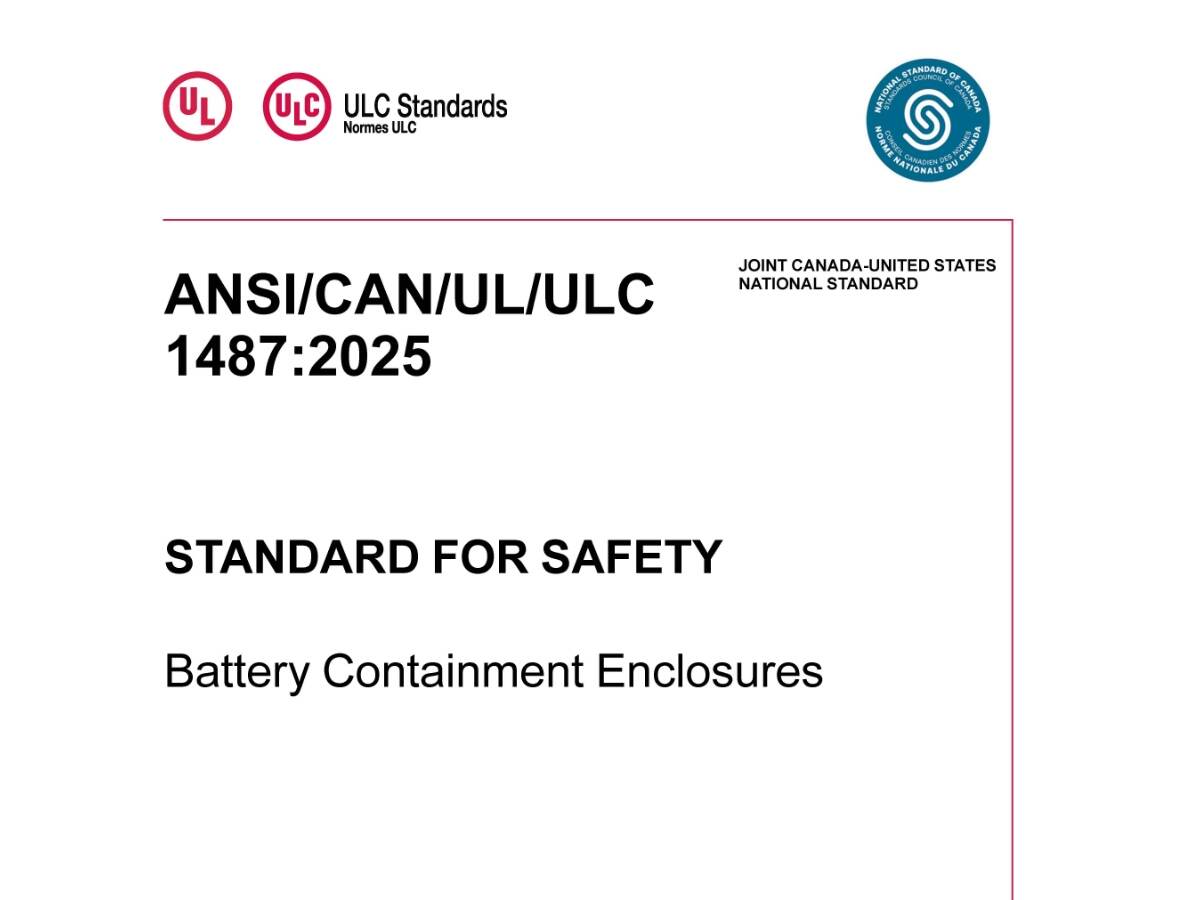Benjamin Gaudet, P.E. Lead R&D Engineer – Fire Research and Development
Kevin Hyland, UL Solutions Principal Engineer - Fire Resistance and Containment
The first edition of UL 1487, the Standard for Battery Containment Enclosures, was published on February 10, 2025, by UL Standards & Engagement as a binational standard for the United States and Canada. UL 1487 is a result of collaboration that started in 2023 amongst interested parties, including industry representatives and manufacturers, fire service, testing and certification organizations and authorities having jurisdiction (AHJs).
Background for UL 1487
The transition to more sustainable energy sources has accelerated the development and use of technologies that can store and release renewable electrical energy to power our world with minimal production of greenhouse gases. A key technology in this transition is the lithium-ion battery. While more advanced battery technologies are being developed, none are as simultaneously energy dense and economically manufactured at scale. As a result, products and devices powered by lithium-ion batteries have proliferated. Tools traditionally powered by two-stroke or four-stroke gasoline engines — including lawn mowers, weed trimmers, leaf blowers, chainsaws and power tools — are being phased out by battery-powered alternatives. E-mobility devices in the form of scooters, power-assist bicycles, mopeds and others have increased in use, especially in urban environments.
Hazards associated with lithium-ion batteries
As with most cases of energy stored in an engineered system, there are potential safety risks if a lithium-ion battery becomes compromised by physical damage, environmental abuse or improper charging. One such risk, known as thermal runaway, is a failure mode of lithium-ion battery cells where the cell temperature increases through self-heating in an uncontrolled fashion. The incident progresses to a point when the rate of heat generated through internal chemical reactions is higher than the rate the cell can dissipate that heat. In the case of lithium-ion batteries, thermal runaway can rapidly release effluent gases that are flammable, explosive and toxic. Thermal runaway effluent gases are primarily mixtures of hydrogen, carbon dioxide, carbon monoxide, hydrocarbons such as methane and electrolyte vapors [1]. With sufficient oxygen, these gas mixtures can ignite promptly, resulting in fire, or after accumulating, resulting in a deflagration.
The increase in the numbers of lithium-ion-battery-powered devices has corresponded to an increase in the number of thermal runaway incidents. This increase in incidents is being observed globally across several product categories [2]. This trend is punctuated in the United States by multiple incidents in New York City and elsewhere involving e-mobility devices that have tragically resulted in serious fires, causing fatalities, injuries and significant property losses [2].
Strategies for lithium-ion battery thermal runaway mitigation
To address the life safety hazards of thermal runaway in consumer products, the central prevention strategies of user education, product regulation and product quality are critical. These approaches take the form of publicly available research, adoption of the most current lithium-ion battery protection measures into model building, installation and fire codes and rigorous product safety standards that are designed to reduce failure rates. In addition to these prevention strategies, battery containment products have emerged which are purpose-built for mitigation of thermal runaway hazards of lithium-ion batteries and battery-powered devices that are stored and charged inside of them. UL 1487, Battery Containment Enclosures, was created to evaluate these products.
Summary of UL 1487 for product certification
UL 1487 is a product standard that addresses the safety performance of a product through both construction and testing requirements. In UL 1487, there are two primary test methods focused on thermal runaway.
First, there is an internal thermal runaway test, which uses a scalable, standardized fuel package of lithium-ion batteries that are purposefully driven into thermal runaway propagation inside the product. The storage cavity energy containment rating (SCECR) forms the basis of the size of the fuel package, and the storage cavity with the largest SCECR is tested.
Second, there is an internal deflagration test that exposes the product to ignition of a standardized flammable mixture inside the product. This condition represents explosive ignition of accumulated thermal runaway effluent gases. The performance criteria of these tests focus on the ability of the product to maintain structural integrity and adequately contain or mitigate fire, explosion and thermal hazards.
UL 1487 includes construction and performance testing assessments for internal electrical power distribution, integral fire protection and life safety systems (together called “integral systems”), environmental exposures, and mechanical loading. These testing programs are intended to be more tailored to a particular product design and end-use application. While they are not centered around thermal runaway, they are nonetheless essential for the overall safe performance and quality of the product.
UL 1487 introduces definitions for some of the product characteristics. For example, a storage cavity is a general term for a shelf, locker, cubby or compartment where batteries are placed. Subsequently, a SCECR is the amount of battery electrical energy, in watt-hours, that may be stored in a storage cavity.
Finally, UL 1487 includes an optional Annex D that outlines an external fire test similar to traditional fire resistance testing. This test results with a fire resistance rating in units of time (e.g., 30 minutes, 1 hour). The intent of this annex is to provide a means of assessing traditional fire resistance ratings that are implemented in fire protection language for lithium-ion battery storage in codes [3].
The release of thermal runaway effluent gases into a surrounding space is a particularly challenging hazard to mitigate. Once generated, the gas must be safely diluted, extracted or neutralized after exiting a battery containment enclosure. Product characteristics, such as dedicated gas vents and smaller SCECRs (i.e., separation) can direct and reduce the potential gas release. However, an additional approach is needed.
The approach within UL 1487 is to mitigate gas release through requirements for the product’s installation and use instructions. This approach acknowledges that while product standards are not installation codes, they can form a foundation for practice in codes by implementing requirements in product instructions.
The standard states mitigation requirements that must be written into product instructions depending on the installation and use location of the product (i.e., indoors or outdoors). For example, recent data on damage potential from partial volume deflagrations of thermal runaway effluent gas was applied to a requirement for minimum indoor compartment size where the product is located (assuming no other compartment-scale explosion mitigation) [4].
Battery containment enclosures intended for indoor installation are assigned a minimum allowable compartment volume, which is the minimum available volume of an enclosed space, such as a room where a battery containment enclosure may be used or installed based on the potential for thermal runaway effluent gas release. The user and installation instructions state that any deviation from this value requires that room-level mitigation strategies must be present and assessed by a licensed engineering professional with explosion expertise. The current scope of UL 1487 does not cover products intended to be installed or used in residential dwellings.
UL 1487 has been proposed for inclusion in the 2027 edition of the International Fire Code (IFC) and the 2027 edition of NFPA 1, Fire Code. The products that will be tested to UL 1487 are designed for a variety of occupancies and applications across multiple industries and consumer areas where battery failures are a hazard. These products, through UL 1487 certification, can then provide another layer of safety for green energy.
Battery containment enclosures certified by UL Solutions to UL 1487 can be found in the online certification directory, UL Product iQ®. Product iQ is available to use at no cost but requires a one-time registration. Search for the product category “Enclosures for Storage, Charging and Containment of Batteries and Battery-Powered Devices” (XHCH, XHCH7), or view the list of current certifications and the Guide Information page.
Model codes summary
The model fire codes have requirements for battery-powered devices focused on mitigating the potential risks of electrical shock and thermal runaway.
2024 NFPA 1 Fire Code
- Section 10.21 Powered Micromobility Devices
- Specific requirements and restrictions for device charging locations and operations
2027 NFPA 1 Fire Code
- A task group has been created to submit new requirements for consideration by NFPA 1 Technical Committee. Work will continue through 2025
- A reference to UL 1487 is anticipated
2024 International Fire Code (IFC)
- Section 322 Powered Micromobility Devices
- Specific requirements and restrictions for device charging locations and operations
- Removable storage batteries shall not be stacked or charged in an enclosed cabinet unless the cabinet is specially designed and approved for such purpose
2027 International Fire Code (IFC) proposals
- Expansion of requirements to include additional types of battery-powered equipment and devices, possibly all in a new chapter
- Expansion of requirements to cover a wider range of battery chemistries (not just Li-ion)
- A reference to UL 1487 and UL 4900, the Outline of Investigation for Micromobility Charging Equipment, is anticipated
References
- Baird, A. R., Archibald, E. J., Marr, K. C., & Ezekoye, O. A. (2020). Explosion hazards from lithium-ion battery vent gas. Journal of Power Sources, 446, 227257.
- UL Solutions Battery Incident Database. (2024). Accessed at: https://www.ul.com/insights/lithium-ion-battery-incident-reporting
- National Fire Protection Association. (2023). NFPA 855: Standard for the Installation of Stationary Energy Storage Systems.
- Sauer, N. G., Gaudet, B., & Barowy, A. (2024). Experimental investigation of explosion hazard from lithium-ion battery thermal runaway effluent gas. Fuel, 378, 132818.

